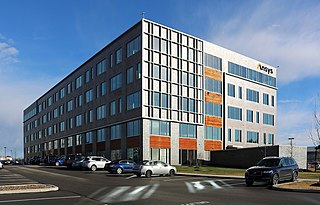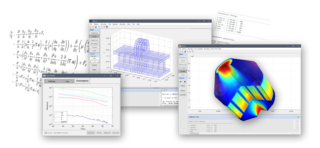
Computer-aided design (CAD) is the use of computers to aid in the creation, modification, analysis, or optimization of a design. This software is used to increase the productivity of the designer, improve the quality of design, improve communications through documentation, and to create a database for manufacturing. Designs made through CAD software are helpful in protecting products and inventions when used in patent applications. CAD output is often in the form of electronic files for print, machining, or other manufacturing operations. The terms computer-aided drafting (CAD) and computer aided design and drafting (CADD) are also used.

Computer-aided engineering (CAE) is the broad usage of computer software to aid in engineering analysis tasks. It includes finite element analysis (FEA), computational fluid dynamics (CFD), multibody dynamics (MBD), durability and optimization. It is included with computer-aided design (CAD) and computer-aided manufacturing (CAM) in the collective abbreviation "CAx".

LS-DYNA is an advanced general-purpose multiphysics simulation software package developed by the former Livermore Software Technology Corporation (LSTC), which was acquired by Ansys in 2019. While the package continues to contain more and more possibilities for the calculation of many complex, real world problems, its origins and core-competency lie in highly nonlinear transient dynamic finite element analysis (FEA) using explicit time integration. LS-DYNA is used by the automobile, aerospace, construction and civil engineering, military, manufacturing, and bioengineering industries.
NASTRAN is a finite element analysis (FEA) program that was originally developed for NASA in the late 1960s under United States government funding for the aerospace industry. The MacNeal-Schwendler Corporation (MSC) was one of the principal and original developers of the publicly available NASTRAN code. NASTRAN source code is integrated in a number of different software packages, which are distributed by a range of companies.

Ansys, Inc. is an American company based in Canonsburg, Pennsylvania. It develops and markets CAE/multiphysics engineering simulation software for product design, testing and operation and offers its products and services to customers worldwide.
MSC Software Corporation is an American simulation software technology company based in Newport Beach, California, that specializes in simulation software.
Dassault Systèmes Simulia Corp. is a computer-aided engineering (CAE) vendor. Formerly known as Abaqus Inc. and previously Hibbitt, Karlsson & Sorensen, Inc., (HKS), the company was founded in 1978 by David Hibbitt, Bengt Karlsson and Paul Sorensen, and has its headquarters in Providence, Rhode Island.
Femap is an engineering analysis program sold by Siemens Digital Industries Software that is used to build finite element models of complex engineering problems ("pre-processing") and view solution results ("post-processing"). It runs on Microsoft Windows and provides CAD import, modeling and meshing tools to create a finite element model, as well as postprocessing functionality that allows mechanical engineers to interpret analysis results. The finite element method allows engineers to virtually model components, assemblies, or systems to determine behavior under a given set of boundary conditions, and is typically used in the design process to reduce costly prototyping and testing, evaluate differing designs and materials, and for structural optimization to reduce weight.

Abaqus FEA is a software suite for finite element analysis and computer-aided engineering, originally released in 1978. The name and logo of this software are based on the abacus calculation tool. The Abaqus product suite consists of five core software products:
- Abaqus/CAE, or "Complete Abaqus Environment". It is a software application used for both the modeling and analysis of mechanical components and assemblies (pre-processing) and visualizing the finite element analysis result. A subset of Abaqus/CAE including only the post-processing module can be launched independently in the Abaqus/Viewer product.
- Abaqus/Standard, a general-purpose Finite-Element analyzer that employs implicit integration scheme (traditional).
- Abaqus/Explicit, a special-purpose Finite-Element analyzer that employs explicit integration scheme to solve highly nonlinear systems with many complex contacts under transient loads.
- Abaqus/CFD, a Computational Fluid Dynamics software application which provides advanced computational fluid dynamics capabilities with extensive support for preprocessing and postprocessing provided in Abaqus/CAE - discontinued in Abaqus 2017 and further releases.
- Abaqus/Electromagnetic, a Computational electromagnetics software application which solves advanced computational electromagnetic problems.
NEi Software, founded as Noran Engineering, Inc. in 1991, is an engineering software company that develops, publishes and promotes FEA software programs including its flagship product NEi Nastran. The FEA algorithms allow engineers to analyze how a structure will behave under a variety of conditions. The types of analysis include linear and nonlinear stress, dynamic, and heat transfer analysis. MCT, PPFA, dynamic design analysis method, optimization, fatigue, CFD and event simulation are just some of the specialized types of analysis supported by the company.
Z88 is a software package for the finite element method (FEM) and topology optimization. A team led by Frank Rieg at the University of Bayreuth started development in 1985 and now the software is used by several universities, as well as small and medium-sized enterprises. Z88 is capable of calculating two and three dimensional element types with a linear approach. The software package contains several solvers and two post-processors and is available for Microsoft Windows, Mac OS X and Unix/Linux computers in 32-bit and 64-bit versions. Benchmark tests conducted in 2007 showed a performance on par with commercial software.

NEi Fusion is a finite element analysis program sold by NEi Software that is used by engineers to build and analyze 3D models of parts and assemblies of various products. NEi Fusion digital-simulation software virtually applies forces, pressures, vibration, acceleration loads, or thermal conditions to 3D models of parts, structures, and assemblies. It obtains results of various engineering parameters, such as deformation, stresses, strains, temperature distributions, and modal shapes the design would experience if implemented. The results, which range from tables of data to contour plots and animations, provide engineering insight. For example, result visualizations like color-coded, contour plots can help deepen understanding of physical phenomena in complex geometry. NEi Fusion consists of a 3D parametric CAD modeler powered by SolidWorks with NEi Nastran finite element analysis solvers. NEi Fusion runs on Microsoft Windows and provides CAD modeling, import and meshing tools.

SimulationX is a CAE software application running on Microsoft Windows for the physical simulation of technical systems. It is developed and sold by ESI Group.
ADINA is a commercial engineering simulation software program that is developed and distributed worldwide by ADINA R & D, Inc. The company was founded in 1986 by Dr. Klaus-Jürgen Bathe, and is headquartered in Watertown, Massachusetts, United States. On April 7, 2022, Bentley Systems acquired ADINA R&D, Inc.

VisualFEA is a finite element analysis software program for Microsoft Windows and Mac OS X. It is developed and distributed by Intuition Software, Inc. of South Korea, and used chiefly for structural and geotechnical analysis. Its strongest point is its intuitive, user-friendly design based on graphical pre- and postprocessing capabilities. It has educational features for teaching and learning structural mechanics, and finite element analysis through graphical simulation. It is widely used in college-level courses related to structural mechanics and finite element methods.
HyperSizer is computer-aided engineering (CAE) software used for stress analysis and sizing optimization of metallic and composite structures. Originally developed at the US National Aeronautics and Space Administration (NASA) as ST-SIZE, it was licensed for commercial use by Collier Research Corporation in 1996. Additional proprietary code was added and the software was marketed under the name HyperSizer.
Simcenter Amesim is a commercial simulation software for the modeling and analysis of multi-domain systems. It is part of systems engineering domain and falls into the mechatronic engineering field.
SmartDO is a multidisciplinary design optimization software, based on the Direct Global Search technology developed and marketed by FEA-Opt Technology. SmartDO specialized in the CAE-Based optimization, such as CAE, FEA, CAD, CFD and automatic control, with application on various physics phenomena. It is both GUI and scripting driven, allowed to be integrated with almost any kind of CAD/CAE and in-house codes.

FEATool Multiphysics is a physics, finite element analysis (FEA), and PDE simulation toolbox. FEATool Multiphysics features the ability to model fully coupled heat transfer, fluid dynamics, chemical engineering, structural mechanics, fluid-structure interaction (FSI), electromagnetics, as well as user-defined and custom PDE problems in 1D, 2D (axisymmetry), or 3D, all within a graphical user interface (GUI) or optionally as script files. FEATool has been employed and used in academic research, teaching, and industrial engineering simulation contexts.









